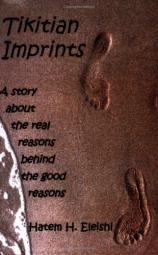Reading Group Guide
Discussion Questions
Tikitian Imprints

1. Title of the book: Discuss the title of the book. What do you think the possible meanings that the word "Tikitian" could stand for? Would you rather suggest another title? Do you think the term "Tikitian" would someday be incorporated into the English vocabulary?
2. Overture of the novel: The author's overture of his novel was with the chapter "Around the World in Eight Persons" where he briefly autobiographed aspects of eight totally different personalities from eight different countries. How did that affect your anticipations and expectations of the succeeding chapters of the book?
3. Location and timing of story: Was the author's description of the Tikitian and Hikandian landscapes a good one? Was the Stone Age time period important to the story? Was pertinent information lumped altogether, or integrated into the story? How did this affect your appreciation of the book?
4. The plot and the characters: What was more important, the plot or the characters? Was the plot moved forward by decisions of the characters, or were the characters at the mercy of the plot? Did the author draw realistic characters? Which character could you relate to best? And why? And which character would you consider the real hero of the book?
5. The author's use of language/writing style: Was the language appropriate to the story? Was there a rhythm to the authors style, or anything else that might be considered unique about it? Was the dialogue realistic sounding?
6. Author's description: Was the author fairly descriptive? Was he better at describing the concrete or the abstract?
7. Shifts of themes: The book started with a description of the daily life of a couple that lived in the Stone Age in what seemed to be an anthropological theme. It then took up an adventurous style with the appearance of the three bipedal leopards in the Tikitian Valley. Thereafter it shifted to the chapters about the social contract and societal compromises. By chapter 11, it made another turn to intense thought-provoking platonic dialogues and lastly it made a fourth rather acute turn to an unexpected spiritual theme in the last three chapters. When through the book could you tell what the author's message from the novel was going to be?
8. In spite of the tough philosophical chapters in Tikitian Imprints, yet, Tikitian Imprints is also a comedy. Comment.
9. Women's rights: It has been argued by some that the author is a genuine advocate of women's rights while others have argued for the opposite. What do you think?
10. Political projections: In chapter 8 "Nothing Scarier than Scared Humans" and in chapter 15 "The Release", there were many political projections. Comment.
11. Models for evolutionary psychology: There is not a single sentimental meaning or value in humans' lives that was not analyzed and broken down to its primitive components. Those included love and intimacy, close friendships, parenthood and daily social interactions between humans. The author provided primitive Stone Age scenarios and models in his attempts to demonstrate his opinions about modern human behavior like for example when the guys trespassed on Habi's territory and ate his grapes. Habi then had to reach a compromise between their eating habits that lessened the food and the anti-panther privilege he would get from befriending them and that was the basis of the social contract from which evolved so many human by-behaviors thereafter including codes of conduct. Another example is the well of water in the desert in chapter 13. To what extent you think the author succeeded in devising and employing his models?
12. Genre of the book: If you were asked to classify the genre of Tikitian Imprints, would you most precisely classify it as fiction or philosophy or politics or relationships or sociology or religion?
13. Imprints of Tikitian Imprints: Has reading this book inspired you in any way or changed your opinion or outlook to certain issues in your life? What do you think will be your lasting impression of the book as a whole? Or will you not think of it at all in a year's time?
Tikitian Imprints
- Publication Date: June 28, 2007
- Paperback: 180 pages
- Publisher: Goose River Press
- ISBN-10: 1597130419
- ISBN-13: 9781597130417






